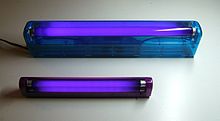-
PHILIPS UV-C LED 5W Sanitization USB Luminaire
Regular price Rp 337.429 IDRRegular priceUnit price / perRp 367.798 IDRSale price Rp 337.429 IDRSale -
PHILIPS UVC Disinfection Desk Lamp
Regular price Rp 1.124.858 IDRRegular priceUnit price / perRp 1.226.095 IDRSale price Rp 1.124.858 IDRSale -
PHILIPS TMS160C UVC Linear Disinfection With Sensor
Regular price Rp 2.268.143 IDRRegular priceUnit price / perRp 2.472.276 IDRSale price Rp 2.268.143 IDRSale -
PHILIPS SM345C C 4xTUV PLS 9W HFM UV-C Disinfection Upper Air CM
Regular price Rp 15.122.715 IDRRegular priceUnit price / perRp 16.483.759 IDRSale price Rp 15.122.715 IDRSale -
PHILIPS UV-C 10L TC GM Home Disinfection Box
Regular price Rp 2.587.000 IDRRegular priceUnit price / perRp 2.819.830 IDRSale price Rp 2.587.000 IDRSale
Collection: UV Light
Ultraviolet (UV) is a form of electromagnetic radiation with wavelengths from 10 nm (with a corresponding frequency around 30 PHz) to 400 nm (750 THz), shorter than that of visible light, but longer than X-rays. UV radiation is present in sunlight and constitutes about 10% of the total electromagnetic radiation output from the Sun. It is also produced by electric arcs and specialized lights, such as mercury-vapor lamps, tanning lamps, and black lights. Although long-wavelength ultraviolet is not considered ionizing radiation because its photons lack the energy to ionize atoms, it can cause chemical reactions and causes many substances to glow or fluoresce. Consequently, the chemical and biological effects of UV are greater than simple heating effects, and many practical applications of UV radiation derive from its interactions with organic molecules.
Short-wave ultraviolet light damages DNA and sterilizes surfaces with which it comes into contact. For humans, suntan and sunburn are familiar effects of exposure of the skin to UV light, along with an increased risk of skin cancer. The amount of UV light produced by the Sun means that the Earth would not be able to sustain life on dry land if most of that light were not filtered out by the atmosphere. More energetic, shorter-wavelength "extreme" UV below 121 nm ionizes air so strongly that it is absorbed before it reaches the ground. However, ultraviolet light (specifically, UVB) is also responsible for the formation of vitamin D in most land vertebrates, including humans. The UV spectrum, thus, has effects both beneficial and harmful to life.
The lower wavelength limit of human vision is conventionally taken as 400 nm, so ultraviolet rays are invisible to humans, although some people can perceive light at slightly shorter wavelengths than this. Insects, birds, and some mammals can see near-UV (i.e., slightly shorter wavelengths than what humans can see).
Short-wave ultraviolet light damages DNA and sterilizes surfaces with which it comes into contact. For humans, suntan and sunburn are familiar effects of exposure of the skin to UV light, along with an increased risk of skin cancer. The amount of UV light produced by the Sun means that the Earth would not be able to sustain life on dry land if most of that light were not filtered out by the atmosphere. More energetic, shorter-wavelength "extreme" UV below 121 nm ionizes air so strongly that it is absorbed before it reaches the ground. However, ultraviolet light (specifically, UVB) is also responsible for the formation of vitamin D in most land vertebrates, including humans. The UV spectrum, thus, has effects both beneficial and harmful to life.
The lower wavelength limit of human vision is conventionally taken as 400 nm, so ultraviolet rays are invisible to humans, although some people can perceive light at slightly shorter wavelengths than this. Insects, birds, and some mammals can see near-UV (i.e., slightly shorter wavelengths than what humans can see).






